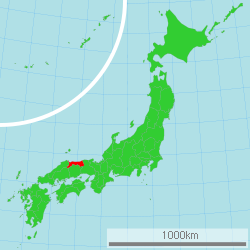Tottori prefecture
|
Tottori Prefecture 鳥取県 |
|||
|---|---|---|---|
| Prefecture | |||
| Japanese transcription(s) | |||
| • Japanese | 鳥取県 | ||
| • Rōmaji | Tottori-ken | ||
|
|||
 |
|||
| Coordinates: 35°27′N 133°46′E / 35.450°N 133.767°ECoordinates: 35°27′N 133°46′E / 35.450°N 133.767°E | |||
| Country | Japan | ||
| Region | Chūgoku (San'in) | ||
| Island | Honshu | ||
| Capital | Tottori | ||
| Government | |||
| • Governor | Shinji Hirai | ||
| Area | |||
| • Total | 3,507.05 km2 (1,354.08 sq mi) | ||
| Area rank | 41st | ||
| Population (June 1, 2016) | |||
| • Total | 570,569 | ||
| • Rank | 47th | ||
| • Density | 163/km2 (420/sq mi) | ||
| ISO 3166 code | JP-31 | ||
| Districts | 5 | ||
| Municipalities | 19 | ||
| Flower | Nijisseiki nashi pear blossom (Pyrus pyrifolia) | ||
| Tree | Daisenkyaraboku (Taxus cuspidata) | ||
| Bird | Mandarin duck (Aix galericulata) | ||
| Website | www |
||
Tottori Prefecture (鳥取県 Tottori-ken?) is a prefecture of Japan located in the Chūgoku region. The capital is the city of Tottori. It is the least populous prefecture in Japan.
The word "Tottori" in Japanese is formed from two kanji characters. The first, , means "bird" and the second, means "to get". Early residents in the area made their living catching the region's plentiful waterfowl. The name first appears in the Nihon shoki in the 23rd year of the Emperor Suiko when Yukuha Tana, an elder from the Izumo, visits the emperor. The imperial Prince Homatsu-wake was unable to speak, despite being 30 years of age.
"Yukuha Tana presented the swan to the emperor. Homatsu-wake no Mikoto played with this swan and at least learned to speak. Therefore, Yukaha Tana was liberally rewarded, and was granted the title of Tottori no Miyakko." (Aston, translation)
Tottori Prefecture was settled very early in the prehistoric period of Japan, as evidenced by remains from the Jōmon period (14,000 – 300 BC). The prefecture has the remains of the largest known Yayoi period (300 BC – 250 AD) settlement in Japan, the Mukibanda Yayoi remains, located in the low foothills of Mount Daisen in the cities of Daisen and Yonago. Numerous kofun tumuli from the Kofun period (250 – 538) are located across the prefecture. In 645, under the Taika reforms, the area in present-day Tottori Prefecture became two provinces, Hōki and Inaba.
...
Wikipedia


